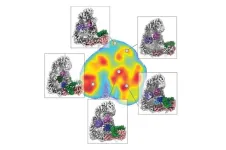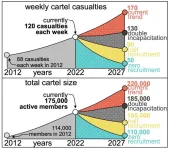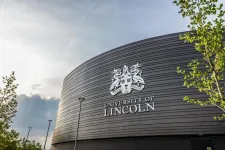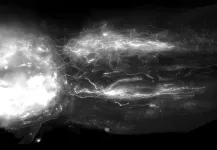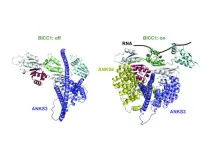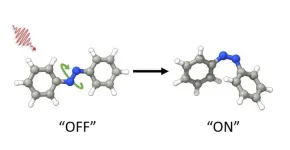(Press-News.org) MINNEAPOLIS/ST. PAUL (09/21/2023) — Michele Statz, PhD, an assistant professor at the University of Minnesota Medical School, Duluth Campus and affiliated faculty with the University of Minnesota Law School’s Human Rights Center, and her research team have been awarded a $1 million grant from the National Science Foundation’s CIVIC Innovation Challenge to improve access to civil justice for rural and Indigenous communities in Alaska. The research team aims to develop a model that can be replicated in other communities across the country.
The “Bridging the Rural Justice Gap: Innovating & Scaling Up Civil Access to Justice in Alaska” project is a collaboration between the U of M Medical School, Alaska Legal Services Corporation (ALSC) and the American Bar Foundation.
The project will focus on addressing the problem of access to justice through the Community Justice Worker (CJW) program—a service delivery model that trains trusted, culturally representative community workers and others already embedded in rural and remote areas across Alaska to provide critical legal advocacy.
“When we think about the enormous financial, health and well-being implications of having an unaddressed civil legal issue, it’s clear that they’re never exclusively ‘legal’ problems,” said Dr. Statz, principal investigator and ABF Affiliated Scholar. “This absolutely changes the way we have to think about them, especially in rural areas where there are very few, if any, attorneys. I’m thrilled to be a part of an initiative that meaningfully honors and brings together the expertise of local stakeholders, community members, researchers and diverse professionals.”
Starting in October, the research team will:
Develop culturally responsive training, supervision and credentialing processes for Community Justice Workers;
Develop best practices for workforce development, recruiting and retaining Community Justice Workers;
Evaluate short- and long-term sustainability models for justice work infrastructure; and
Produce a framework for community-engaged research and evaluation.
The co-principal investigators on this project are Matthew Burnett, senior program officer for the Access to Justice Research Initiative at the American Bar Foundation and Nikole Nelson, executive director of Alaska Legal Services Corporation. The project was previously awarded a Stage 1 Planning Grant from the CIVIC Innovation Challenge, and is one of only 19 teams selected to receive a Stage 2 Grant to fund their project over one year.
###
About the University of Minnesota Medical School
The University of Minnesota Medical School is at the forefront of learning and discovery, transforming medical care and educating the next generation of physicians. Our graduates and faculty produce high-impact biomedical research and advance the practice of medicine. We acknowledge that the U of M Medical School, both the Twin Cities campus and Duluth campus, is located on traditional, ancestral and contemporary lands of the Dakota and the Ojibwe, and scores of other Indigenous people, and we affirm our commitment to tribal communities and their sovereignty as we seek to improve and strengthen our relations with tribal nations. For more information about the U of M Medical School, please visit med.umn.edu.
END
University of Minnesota Medical School assistant professor, research team awarded $1 million grant to improve access to legal advocacy for rural and Indigenous communities
2023-09-21
ELSE PRESS RELEASES FROM THIS DATE:
Scientists reveal intricate mechanisms cells use to build protein destruction signals
2023-09-21
Within the intricate molecular landscape inside of a cell, the orchestration of proteins demands precise control to avoid disease. While some proteins must be synthesised at specific times, others require timely breakdown and recycling. Protein degradation is a fundamental process that influences cellular activities such as the cell cycle, cell death, or immune response. At the core of this process lies the proteasome, a recycling hub in the cell. The proteasome degrades proteins if they carry a molecular tag formed by a chain of ubiquitin molecules. The task of attaching this tag falls to enzymes known as ubiquitin ligases.
This process, known ...
Moms’ ability to ‘remember’ prior pregnancies suggests new strategies for preventing complications
2023-09-21
Scientists have known for decades that pregnancy requires a mother’s body to adjust so that her immune system does not attack the growing fetus as if it were a hostile foreign invader. Yet despite learning a great deal more about the immunology of pregnancy in recent years, a new study shows that the cellular crosstalk between a mother and her offspring is even more complex and long-lasting than expected.
The study was published online Sept. 21, 2023, in the journal Science by a research team led by Sing Sing Way, MD, PhD, Division of Infectious Diseases at Cincinnati Children’s and the Center ...
Curbing violence in Mexico: Disrupting cartel recruitment holds the key, a new study finds
2023-09-21
Not through courts and not through prisons. The only way to reduce violence in Mexico is to cut off recruitment. Increasing incapacitation instead leads to both more homicides and cartel members, researcher Rafael Prieto-Curiel from the Complexity Science Hub and colleagues show in a study in Science.
In 2021, approximately 34,000 people died from intentional homicides in Mexico – the equivalent of nearly 27 victims per 100,000 population. This ranks Mexico among the least peaceful countries worldwide.
FIFTH LARGEST EMPLOYER
In order to be able to address this violence ...
Rewiring tumor mitochondria enhances the immune system’s ability to recognize and fight cancer
2023-09-21
Immunotherapy, which uses the body’s own immune system to fight cancer, is an effective treatment option, yet many patients do not respond to it. Thus, cancer researchers are seeking new ways to optimize immunotherapy so that it is more effective for more people. Now, Salk Institute scientists have found that manipulating an early step in energy production in mitochondria—the cell’s powerhouses—reduces melanoma tumor growth and enhances the immune response in mice.
The study, published in Science on September 21, ...
Two studies indicate CO2 on Europa’s surface originated from within the moon’s internal ocean
2023-09-21
A pair of independent studies, using recent James Webb Space Telescope (JWST) observations of carbon dioxide (CO2) ice on Jupiter’s moon Europa, indicate the CO2 originates from a source within the icy body’s subsurface ocean. The findings from both research groups provide new insights into the poorly known composition of Europa’s internal ocean. Beneath a crust of solid water ice, Jupiter’s moon Europa is thought to have a subsurface ocean of salty liquid water. Because of this, Europa is a prime target in the search for life elsewhere in the Solar System. Assessing this deep ...
Global study reveals extensive impact of metal mining contamination on rivers and floodplains, suggesting need for new safeguards to address spike in demand for ‘green’ minerals
2023-09-21
A groundbreaking study, published today in Science, has provided new insights into the extensive impact of metal mining contamination on rivers and floodplains across the world, with an estimated 23 million people believed to be affected by potentially dangerous concentrations of toxic waste.
Led by Professors Mark Macklin and Chris Thomas, Directors of the Lincoln Centre for Water and Planetary Health at the University of Lincoln, UK – working with Dr Amogh Mudbhatkal from the University’s Department of Geography – the study offers a comprehensive understanding of the environmental and health challenges associated with metal mining activities.
Using ...
Regeneration across complete spinal cord injuries reverses paralysis
2023-09-21
When the spinal cords of mice and humans are partially damaged, the initial paralysis is followed by the extensive, spontaneous recovery of motor function. However, after a complete spinal cord injury, this natural repair of the spinal cord doesn’t occur and there is no recovery. Meaningful recovery after severe injuries requires strategies that promote the regeneration of nerve fibers, but the requisite conditions for these strategies to successfully restore motor function have remained elusive.
“Five years ago, we demonstrated that nerve fibers can be regenerated across anatomically complete spinal cord ...
The dance of organ positioning: a tango of three proteins
2023-09-21
In order to keep track of their environment, cells use cilia, antenna-like structures that can sense a variety of stimuli, including the flow of fluids outside the cell. Genetic defects that cause cilia to malfunction and lose their sensory abilities can result in disorders known as “ciliopathies”, including polycystic kidney diseases; but they can also disrupt the correct asymmetric positioning of internal organs during embryonic development – what is known as “organ laterality”.
An example of such asymmetry is the heart, which is typically ...
Using harmless light to change azobenzene molecules with new supera molecular complex
2023-09-21
New discovery allows scientists to change the shape of azobenzene molecules using visible light, which is more practical and safe than previously used ultraviolet light. Azobenzenes are incredibly versatile and have many potential uses, such as in making tiny machines and improving technology as well as making light controllable drugs. This molecule can switch between two different forms by light. However, the two forms are in equilibrium, which means that a mixture present that prevents optimal use for applications. Being able to control them with visible light and enrich only one form opens up new possibilities for these applications, making them more efficient ...
Scientists regenerate neurons that restore walking in mice after paralysis from spinal cord injury
2023-09-21
In a new study in mice, a team of researchers from UCLA, the Swiss Federal Institute of Technology, and Harvard University have uncovered a crucial component for restoring functional activity after spinal cord injury. The neuroscientists have shown that re-growing specific neurons back to their natural target regions led to recovery, while random regrowth was not effective.
In a 2018 study published in Nature, the team identified a treatment approach that triggers axons — the tiny fibers that link nerve cells and enable them to communicate — to regrow after spinal cord injury ...
